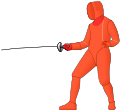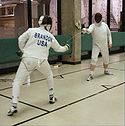.gif)
Épée (fencing)
Encyclopedia

Rapier
A rapier is a slender, sharply pointed sword, ideally used for thrusting attacks, used mainly in Early Modern Europe during the 16th and 17th centuries.-Description:...
, used in sport fencing
Fencing
Fencing, which is also known as modern fencing to distinguish it from historical fencing, is a family of combat sports using bladed weapons.Fencing is one of four sports which have been featured at every one of the modern Olympic Games...
). Épée is French
French language
French is a Romance language spoken as a first language in France, the Romandy region in Switzerland, Wallonia and Brussels in Belgium, Monaco, the regions of Quebec and Acadia in Canada, and by various communities elsewhere. Second-language speakers of French are distributed throughout many parts...
for "sword".
As a thrusting weapon the épée is similar to a foil (compared to a sabre
Sabre (fencing)
The sabre is one of the three weapons of modern sport fencing, and is alternatively spelled saber in American English. The sabre differs from the other modern fencing weapons, the épée and foil, in that it is possible to score with the edge of the blade; for this reason, sabreur movements and...
), but has a stiffer blade that is V-shaped in cross-section, has a larger bell guard, and is heavier. The technique however, is somewhat different, as there are no rules regarding priority and right of way. In addition, the entire body is a valid target area.
Background

Fencing
Fencing, which is also known as modern fencing to distinguish it from historical fencing, is a family of combat sports using bladed weapons.Fencing is one of four sports which have been featured at every one of the modern Olympic Games...
has three weapons (foil, épée, and sabre), each a separate event, épée is the only one in which the entire body is the valid target area. Épée is the heaviest of the three modern fencing weapons. Fencing matches with the épée requires a large amount of concentration, accuracy and speed. Since the entire body is a target, a successful épée fencer must be able anticipate their opponent's move and strike their opponent at the correct time.
In most higher-level competitions a grounded metal piste
Piste (fencing)
In modern fencing, the piste or strip is the playing area. Regulations require the piste to be 14 metres long and between 1.5 and 2 metres wide. The last two metres on each end are hash-marked to warn a fencer before he/she backs off the end of the strip, after which is a 1.5 to 2 metre runoff...
is used to prevent floor hits from registering as touches. Unlike sabre and foil, in épée there are no right-of-way rules regarding attacks. Touches are awarded solely on the basis of which fencer makes a touch first, according to the electronic scoring machines. Also, double-touches are allowed in épée, although the touches must occur within 40 milliseconds (1/25 of a second) of each other.
The weapon
A modern épée for use by adult fencers has a blade which measures 90 centimeters from the bell guard to the tip; the maximum allowable mass is 770g, but most competition swords are much lighter, weighing 300g - 450g. Épées for use by children under 12 are shorter and lighter, making it easier for them to use.The épée has a three-sided blade, in contrast to the foil and sabre which are rectangular in cross section. In competitions a valid épée touch is scored if a fencer touches the opponent with enough force to depress the tip; by rule, this is a minimum force
Force
In physics, a force is any influence that causes an object to undergo a change in speed, a change in direction, or a change in shape. In other words, a force is that which can cause an object with mass to change its velocity , i.e., to accelerate, or which can cause a flexible object to deform...
of 750 gram-forces (7.4 N). Since the hand is a valid target, the bellguard is much larger than that of the foil. The bell guard is typically made of aluminum or stainless steel. The tip is wired to a connector in the bellguard, then to an electronic scoring device or "box." The bellguard, blade, and handle of the épée are all grounded
Ground (electricity)
In electrical engineering, ground or earth may be the reference point in an electrical circuit from which other voltages are measured, or a common return path for electric current, or a direct physical connection to the Earth....
to the scoring box to prevent hits to the weapon from registering as touches.
In the groove formed by the V-shaped blade, there are two thin wires leading from the far end of the blade to a connector in the bellguard. These wires are held in place with a strong glue. The amount of glue is kept to a minimum as in the unlikely (but possible) case that a fencer manages a touch in that glue, the touch would be registered on the electrical equipment, as the glue is not conductive (the blade is grounded). In the event of tip to tip hits, a point should not be awarded. A "body cord" with a three-pronged plug at each end is placed underneath the fencer's clothing and attached to the connector in the bellguard, then to a wire leading to the scoring box. The scoring box signals with lights (one for each fencer) and a tone each time the tip is depressed.
The tip of an épée comprises several parts including: the mushroom-shaped movable tip; its housing or "barrel", which is threaded to the blade; a contact spring; and a return spring. The tips are generally held in place by two small grub screws, which thread into the sides of the tip through elongated openings on either side of the barrel. The screws hold the tip within the barrel but are allowed to travel freely in the openings. While this is the most common system, screwless variations do exist. The return spring must allow the tip to support a force of 750 gf (7.4 N) without registering a touch. Finally, an épée tip must allow a shim of 1.5 mm to be inserted between the tip and the barrel, and when a 0.5 mm shim
Shim (fencing)
In fencing, shims are thin pieces of metal used to test that épée tips conform to specifications. If the shim can be inserted into the narrow gap of the weapon tip, the gap is the correct size. Saber has a similar set of shims used to determine whether or not the blade is correct thickness. Foil...
is inserted and the tip depressed, it should not register a touch. The contact spring is threaded in or out of the tip to adjust for this distance. These specifications are tested at the start of each bout during competitions. During competitions, fencers are required to have a minimum of two weapons and two body wires in case of failure or breakage.
Each fencing weapon has a different tempo, and like épée, the tempo for foil is rather slow with sudden bursts of speed. Sabre is fast throughout the entire touch.
History
As a French word, épée simply means "sword" (ultimately a derivation from spathaSpatha
The spatha was a type of straight sword, measuring between , in use throughout first millennium AD Europe, and in the territory of the Roman Empire until about 600 AD. Later swords from 600 AD to 1000 AD are recognizable derivatives, though they are not spathae.The spatha was used in gladiatorial...
). As an English term, épée was introduced in the 1880s for the sportive fencing weapon.
Like the foil
Foil (fencing)
A foil is a type of weapon used in fencing. It is the most common weapon in terms of usage in competition, and is usually the choice for elementary classes for fencing in general.- Components:...
(fleuret), the épée evolved from light civilian
Civilian
A civilian under international humanitarian law is a person who is not a member of his or her country's armed forces or other militia. Civilians are distinct from combatants. They are afforded a degree of legal protection from the effects of war and military occupation...
weapons such as the smallsword, which since the late 17th century had been the most commonly used dueling sword, replacing the rapier
Rapier
A rapier is a slender, sharply pointed sword, ideally used for thrusting attacks, used mainly in Early Modern Europe during the 16th and 17th centuries.-Description:...
.
The dueling sword developed in the 19th century when, under pressure from the authorities, duel
Duel
A duel is an arranged engagement in combat between two individuals, with matched weapons in accordance with agreed-upon rules.Duels in this form were chiefly practised in Early Modern Europe, with precedents in the medieval code of chivalry, and continued into the modern period especially among...
s were more frequently fought until "first blood" only, instead of to the death. Under this provision, it became sufficient to inflict a minor nick on the wrist or other exposed area on the opponent in order to win the duel.
This had consequences for both fencing technique and design of the weapon.
Rapiers with full cup-guards had been made since the mid 17th century, but were not widespread before the 19th century.
Today, épée fencing very much resembles 19th century dueling. An épée fencer must hit the target with the tip of the weapon. A difference between épée and foil versus sabre is that a corps-à-corps or "body-to-body" contact between fencers is not necessarily an offense, unless it is done with "brutality or violence"; however, corps-à-corps still results in an immediate "halt" to play.
In the pre-electric era, épéeists used a point d'arrêt ("stopping point"), a three-pronged point with small protruding spikes, which would snag on the opponent's clothing or mask, helping the referee to see the hits. The spikes caused épée fencing to be a notoriously painful affair, and épéeists could be easily recognized by the tears in their jacket sleeves. Today non-electric weapons (typically used for practice) are generally fitted with plastic buttons.
See also
- Sabre (fencing)Sabre (fencing)The sabre is one of the three weapons of modern sport fencing, and is alternatively spelled saber in American English. The sabre differs from the other modern fencing weapons, the épée and foil, in that it is possible to score with the edge of the blade; for this reason, sabreur movements and...
- Foil (fencing)Foil (fencing)A foil is a type of weapon used in fencing. It is the most common weapon in terms of usage in competition, and is usually the choice for elementary classes for fencing in general.- Components:...
- FencingFencingFencing, which is also known as modern fencing to distinguish it from historical fencing, is a family of combat sports using bladed weapons.Fencing is one of four sports which have been featured at every one of the modern Olympic Games...
- Small swordSmall swordThe small sword or smallsword is a light one-handed sword designed for thrusting which evolved out of the longer and heavier rapier of the late Renaissance. The height of the small sword's popularity was between mid 17th and late 18th century...
- ColichemardeColichemardeColichemarde is a type of small sword blade that was popular from the late 17th century to the middle 18th century.-Overview:The small sword is considered to be a descendant of the "transition rapier", which itself evolved from the rapier due to the demand for a lighter sword better suited to...

